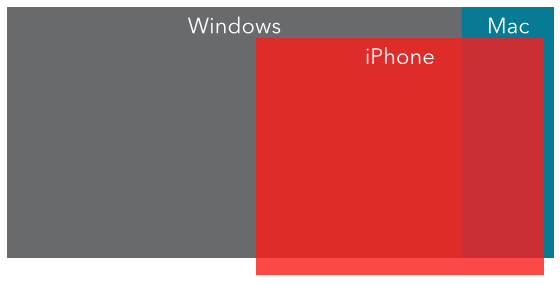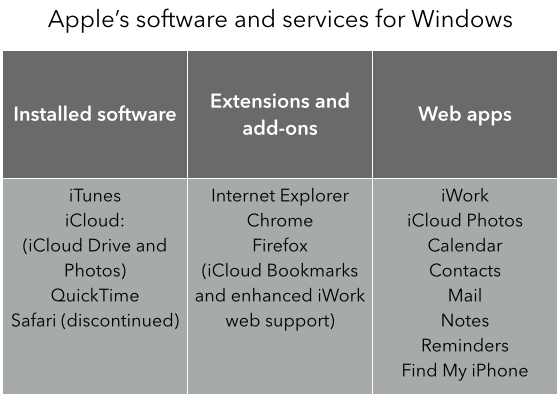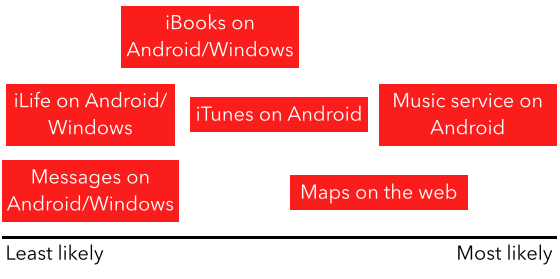A few months back, I wrote this piece which talked among other things about why Apple doesn’t make most of its services available on third-party devices. The basic argument can be summed up in this quote from that piece:
When the whole rationale for Apple’s software is to add value to its hardware products, the idea of providing cross-platform software or services becomes inimical. To the extent that Apple software or services are available on non-Apple devices, they cease to provide meaningful differentiation for Apple products.
However, Apple has continued to make some services available on third party devices, and I see potential for more of this in future. I definitely don’t see Apple abandoning the strategy I outlined in that post, but I do see potential for them to broaden the range of what they provide on non-Apple devices, so in this piece I’m going to argue the other side of that earlier piece.
The iPhone and Mac installed bases
The key to all this is to understand the difference between the iPhone and Mac installed bases. The iPhone is now in every way Apple’s lead product – it accounts for half to two thirds of total revenue in any given quarter and the lion’s share of profits. And it’s also the Apple product with by far the largest installed base. Let’s look at the numbers quickly:
- iPhone: around 450 million users
- iPad: around 200 million users
- Mac: around 80 million users.
We’ve leave the iPad to one side and focus on the iPhone and Mac. What this leaves us with is a world where there’s only very partial overlap between iPhone users and Mac users, with the vast majority of iPhone users likely owning or using Windows PCs rather than Macs, if they use a PC at all:
 Apple has done a great deal over the past couple of years to better serve Mac + iPhone users (including those who also have iPads), including various iCloud features, and the Handoff and Continuity concepts and their associated feature sets announced at last year’s WWDC. All this makes owning more than one Apple device better than owning just one, because the devices you have work better together. The Apple Watch extends this even further, and deepens the attractiveness of an all-Apple ecosystem.
Apple has done a great deal over the past couple of years to better serve Mac + iPhone users (including those who also have iPads), including various iCloud features, and the Handoff and Continuity concepts and their associated feature sets announced at last year’s WWDC. All this makes owning more than one Apple device better than owning just one, because the devices you have work better together. The Apple Watch extends this even further, and deepens the attractiveness of an all-Apple ecosystem.
300 million Windows + iPhone users
However, there are still several hundred million iPhone users who don’t own or use Macs on a daily basis, many of whom do use Windows PCs, either by choice or because work, cost constraints, or other reasons require them to. This Windows + iPhone group is actually substantially bigger than the Mac + iPhone group Apple has spent so much time serving, probably around three hundred million or more:
 In an ideal world, Apple would have these Windows + iPhone users become Mac + iPhone users over time, but that isn’t a realistic scenario for a variety of reasons, especially in the short term. So, how does Apple serve these users?
In an ideal world, Apple would have these Windows + iPhone users become Mac + iPhone users over time, but that isn’t a realistic scenario for a variety of reasons, especially in the short term. So, how does Apple serve these users?
iTunes on Windows and beyond
Well, the answer began with the launch of iTunes on Windows in 2003, two years after the original launch on the Mac, in an attempt to create a market for the iPod larger than the base of Mac users. With the launch of the iPhone, Apple piggybacked off this iTunes installed base as a way to make that product, too, Windows compatible. Since that time, Apple has introduced a few other pieces of installable software for Windows PCs, but much of its effort in supporting Windows users recently has been in the form of web apps rather than native software: iCloud Drive is the only new product Apple has introduced for Windows recently, and it builds on earlier versions of the iCloud product for Windows, which enables some of the extensions and add-ons shown in the middle column in the table above too. But Apple has now made a fairly wide range of products and services available on the web, at iCloud.com, as shown in that third column. These serve the Windows+iPhone reasonably well for some use cases, though I can’t imagine as a Windows user wanting to use the web versions of the iWork suite as my main productivity apps.
iCloud Drive is the only new product Apple has introduced for Windows recently, and it builds on earlier versions of the iCloud product for Windows, which enables some of the extensions and add-ons shown in the middle column in the table above too. But Apple has now made a fairly wide range of products and services available on the web, at iCloud.com, as shown in that third column. These serve the Windows+iPhone reasonably well for some use cases, though I can’t imagine as a Windows user wanting to use the web versions of the iWork suite as my main productivity apps.
What’s missing?
At this point, it’s worth asking what else Apple needs to do to make its products available on third party devices, and whether it’s likely to do so. Here’s a short list of potential next steps:
- A web version of Maps
- iTunes on Android devices
- The Apple music subscription service on Android
- Messages on Windows and/or Android
- The iLife apps on Windows and/or Android
- iBooks on Windows and Android.
There may be one or two other gaps, but I think that about covers it. Which of these seem most likely at this point? The diagram below shows my estimate of the likelihood of each of these things happening: If Apple hadn’t acquired Beats in order to build a subscription music service, I would have put the likelihood of Apple’s music service landing on Android much lower than I have, but since Tim Cook has already signaled that Beats will remain on Android, it seems a fairly sure bet that the successor will be there too. I don’t quite understand the strategic rationale here – almost anything on Android seems to fly in the face of Steve Jobs’ quote in the Walter Isaacson book:
If Apple hadn’t acquired Beats in order to build a subscription music service, I would have put the likelihood of Apple’s music service landing on Android much lower than I have, but since Tim Cook has already signaled that Beats will remain on Android, it seems a fairly sure bet that the successor will be there too. I don’t quite understand the strategic rationale here – almost anything on Android seems to fly in the face of Steve Jobs’ quote in the Walter Isaacson book:
We put iTunes on Windows in order to sell more iPods. But I don’t see an advantage of putting our music app on Android, except to make Android users happy. And I don’t want to make Android users happy.
The only real explanation I can see (beyond maintaining the status quo ante with Beats) is that Apple is competing head-on here against existing subscription music services, all of which are available cross-platform, so this is a concession to reality. But it still feels odd.
Maps on the web seem very likely to me – Google’s web maps were a fantastic hook for Android when it arrived, because it allowed people to make a seamless transition from the product they used on the web for planning, figuring out a route and so on to the one they used on their smartphone for actually navigating from A to B. The fact that Apple doesn’t have a Maps option for anyone using a Windows PC means that those users are far more likely to use other mapping services both on the web and on their phones, or to have disconnected experiences on those two devices. Apple has posted job listings several times (including one that was noticed today) indicating that it might be looking to bring its Maps app to the web, and this seems eminently believable. I’m only putting this slightly lower than the subscription service on Android because that seems largely a foregone conclusion, whereas Apple seems to have been toying with the idea of a web maps app for some time without pulling the trigger.
Essentially everything else I listed seems significantly less likely to happen, although if the music subscription service lands on Android it might make sense to make the full iTunes experience available on Android too. iBooks makes little sense as a cross-platform product – people don’t read many books on their PCs in comparison to tablets and smartphones, while porting iLife would be a huge effort and significantly undercut one of the differentiators of the Mac. Messages was actually the specific focus of the earlier post I referred to at the outset of this one, and I outlined there the reasons I can’t see that happening. It feels like the archetypical example of Apple’s own-devices-only strategy, and it’s also uniquely mobile-first among all these products.
We’ll know more next week
I’m writing this the week before WWDC, where I expect that at the very least we’ll see the music subscription service launch and know whether it will indeed land on Android in either its full or a watered down form. But we’ll likely also get more clues about how Apple sees the opportunity beyond its own devices, and whether the current set of products and services for the Windows + iPhone crowd represents the outer limits of how far Apple is willing to go to keep them happy.